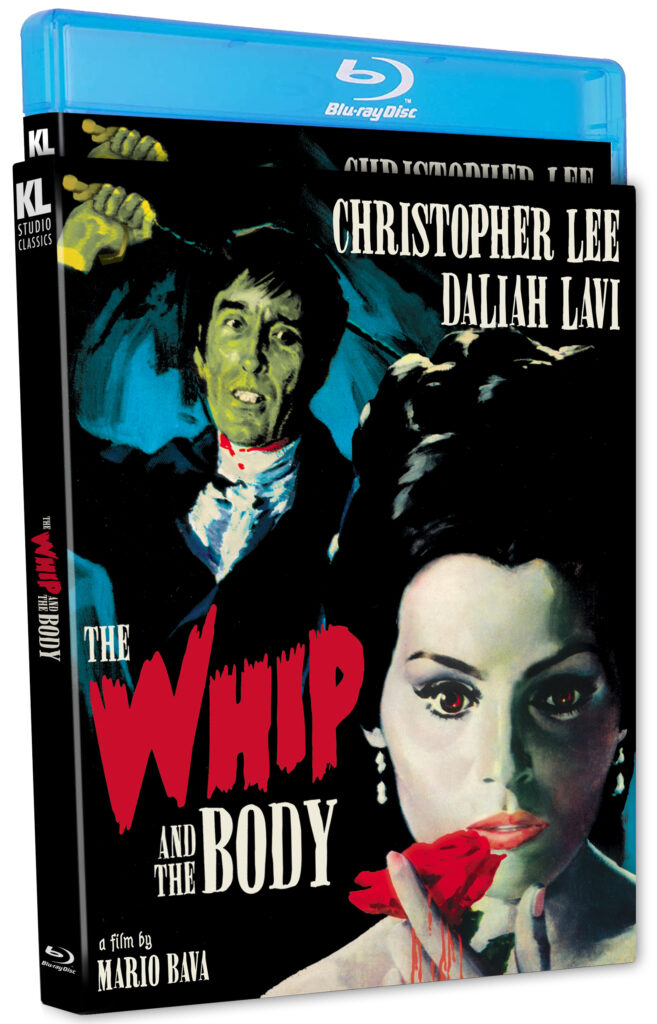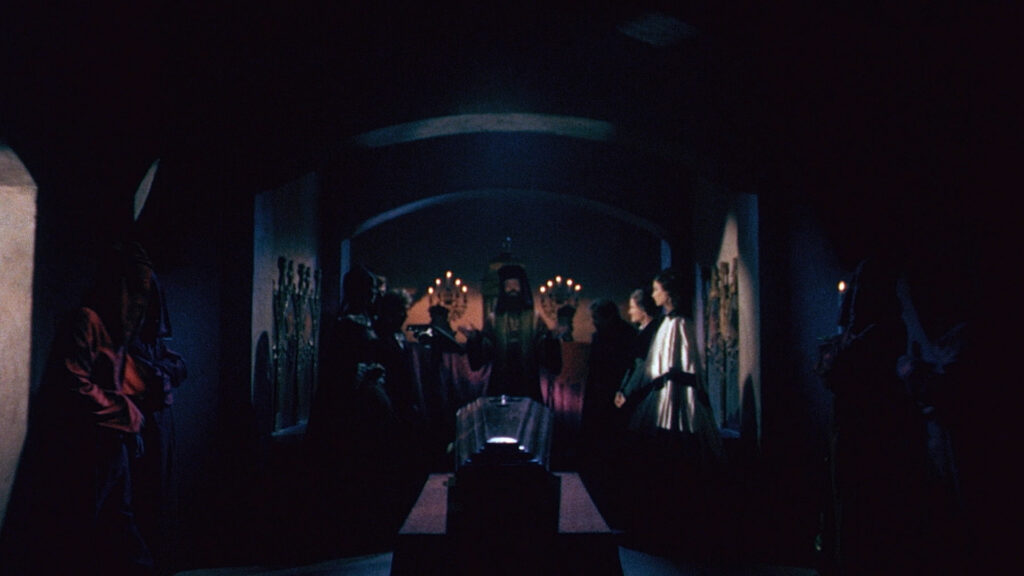Gothic Romance Receives Darker Twist – At The End Of A Coiled Rope
DIRECTOR: MARIO BAVA (Credited As “John M. Old”)
STREET DATE: MARCH 12TH, 2024/KINO LORBER STUDIO CLASSICS

A nodding acquaintance with and/or glancing interest in postwar Italian genre films and mid-century European co-productions, which just about describes this reviewer’s level of lacking expertise, nonetheless frequently reveals what one might optimistically describe as their artists’, technicians’, and practitioners’ perverse pleasure in various indignities and marked shortcomings related to their making, release, distribution, and ultimately their critical and audience reception.
Initially inspired by American International Pictures’ and director Roger Corman’s adaptations of Edgar Allan Poe, particularly 1961’s The Pit and the Pendulum, the higher-end creative and artistic collaboration on a lower-end budget yielded an approximately 90-minute cut of a film originally titled La frusta e il corpo, which, due to various complications and controversies of content and crediting, ended up being shorn of 10-15 minutes wherever it happened to play, and retitled at the whim of any distributor who happened to subsequently pick it up. Even the (unusual) gambit of its (uncredited) producers dictating that their creative personnel take generically “American”-sounding names, in an effort to broaden it subject matter’s difficult appeal – its trio of writers Ernesto Gastaldi, Ugo Guerra, and Luciano Martino becoming “Julian Berry, Robert Hugo, and Martin Hardy”; cinematographer Ubaldo Turzano becoming “David Hamilton”; composer Carlo Rustichelli becoming “Jim Murphy”; and finally, director Mario Bava himself, tasked with coming up with “any old name”, choosing “John M. Old” – came to naught as Night is the Phantom, as it was known in the UK, and the purposely puzzling pronoun What, as it in all senses abbreviately played in the US, failed to recover the cost of its production during its original run.
As Tim Lucas points out in his circa 2000-recorded DVD commentary, included with Kino Lorber’s new special edition Blu-ray reissue, the literal translation of its original Italian title, The Whip and the Body, was never actually released anywhere in the world under that astonishing English-language descriptor, and it is only through the vindication of time – the import of its still shocking poster of grave-complexioned Christopher Lee wielding the title-instrument in anticipation of Daliah Lavi, cupping the bleeding tendrils of a red rose to her soft lips, and her alabaster title-flesh; finally liberated by the two words most accurately describing their visual dynamic – that its sadomasochistic themes can be fairly extrapolated from its Gothic romantic trappings, and its contemporaneously unique horror elements more adequately appreciated. The Whip and the Body, then, emerges from the heavier-colored light-shadings of its original production to potentially greater sympathetic appraisal, especially by those most susceptible to its possibly(?) rewarding artistic pains.

Set vaguely in the 19th century in a still more obscure middle-european country – the social and religious trappings of its wind-howling and darker-spectrum backdrop, ambiguously placed between Catholic and Orthodox, Western and Eastern sympathies, suggesting a poetically evocative anti-utopia – a disinherited Kurt Menliff (Christopher Lee) returns along the blasted shoreline to the family castle overlooking the picturesque gloomy landscape, ostensibly to congratulate his brother Christiano (Tony Kendall) on his recent marriage, but actually arriving to re-stake his claim on Christiano’s new bride, formerly Kurt’s mistress, Nevanka (Daliah Lavi). Instantly greeted with distrust and suspicion by his father the Count (Gustavo De Narvo), distaste by the pure-minded Katia (Ida Galli), and all three by the Menliff’s married servants Losat and Giorgia (Harriet Medin, Luciano Pigozzi), the motives of everyone are called quickly into question when Kurt is found stabbed through his neck by a jeweled dagger formerly on prominent display in a glass-dome trophy case.
Especially affected by the murderous act is Nevanka herself, who just before Kurt’s death was found by Losat and Giorgia stripped to her waist on the beach, whiplashed to unconsciousness, and on the edge of sexual frenzy, despite her apparent physical distress. Past Kurt’s funeral and interment in the family crypt, however, further unexplained acts, including additional murder, muddy footprints in the hallway, and spectral, disembodied cries through the night, casts further suspicion on the nature of Kurt and Nevanka’s past relationship, which has somehow through its physical manifestations of pain, blood, and violence managed to have survived death itself.

Unfolding at a pace charitably described as deliberate, the strange setting and stranger atmosphere derive stylistically from art director Ottavio Scotti’s incredible interiors as illuminated, or more accurately unilluminated, by Ubaldo Terzano and an uncredited Mario Bava’s low-lighting and gel-filtered camerawork. “Painting with light” is perhaps something of a cliche when describing cinematography that seems to fill the frame with the precision of an artist’s brush, but it is nevertheless entirely accurate to the motion-images that appear as richly as a classically-composed oil canvas, shifting artistic perspective within its narratively-driven, three-dimensional space. Those levels of light, and especially their precision use of color, seem to carry as much psychological weight as thematic significance, say, when an unusually darker shade of blue, splashed on the wall and framing the singularly conflicted heroine in statute-like repose and cameo-circled profile, corresponds precisely to the color of moonlight just outside the window behind.
This marked stylistic emphasis on the troubled Nevanka – in one bravura sequence, visually connecting the reflected orbs of both her rolling eyes and the shooting tendrils of her unkempt hair with the feeble rays of the pale moon shining behind a cluster of dark clouds – sets The Whip and the Body distinctly apart from the more male-oriented Edgar Allan Poe adaptations of AIP and Roger Corman. Their emphasis on the Poe antihero, usually embodied by Vincent Price, circumscribed in Bava’s film to an offscreen and shadowy threat in the more ghost-like presence of Christopher Lee, is here considerably shifted to what we might turn the “Ligeia” figure by wholly visualizing the screen-palpable fears and desires of Daliah Lavi’s Nevanka. If The Pit and the Pendulum (1961) had been mainly told from the perspective of Price’s historically-possessed male torturer, then, The Whip and the Body reverses that narrative emphasis to the physical (and sexual) obsessions of the female tortured, suggesting a distinctly heightened emotional as opposed to purely supernatural bond between Ivanka and Kurt that transcends the earthly and material.
At the end of a whip! Of course the full equation of the title requires a recipient to its coiling lash, and undoubtedly its depiction of a full-on sadomasochistic – and postmortem – relationship proved a bit pun-intentionally stinging for audiences of its day, even in a boundary-pushing genre film. But, barring a less sympathetic viewing of the transgressive relationship between the wielder and recipient of its deep-reddened scourge, perhaps the High Gothic atmosphere provided by Bava and his collaborators have by this point provided a more acceptable understanding of and emotional entrance to the love-hate nature of their dark, fairy tale romance.


Or perhaps not? An “acquired taste” is how audio commentator Tim Lucas diplomatically referred to the overall viewing effect of The Whip and the Body halfway through his admirably measured celebration, defense of, and apologia for an admittedly difficult film; giving that he recorded it over two decades ago making it a “classic” itself by Kino Lorber Studio Classics’ own definition. One of his first? Possibly, and as an acknowledged master of the format, Lucas here balances relevant historical, biographical, and production detail with scene-by-scene analysis, the latter effectively putting home viewers squarely in the position of seeing the film through his discerning eye as he elegantly, vocally describes it. I’ll admit my first viewing tended to tax both my patience and my understanding, the characters and their motives tending to often blur into the darkened background, but Lucas may help even the most resistant viewers to better “see” some of those partially-obscured depths and half-hidden visual treasures.
All the Colors of the Dark indeed became the title, eventually published in 2007, of Tim Lucas’s then in-progress and now undoubtedly definitive critical study of Mario Bava’s complete filmography, commanding prices in its limited edition upwards of four figures online. Short of shelling out that kind of cash, one can fortunately do no worse than Kino Lorber’s special edition Blu-ray, which now offers the highest digital-resolution of the Mario Bava film that possibly best demonstrates Mr Lucas’s masterful choice of description. A difficult view, perhaps, but one that may ultimately offer considerable pleasure through its visual challenges and thematic pains.
Images used in this review are credited to DVDBeaver and are taken directly from Kino Lorber’s special edition Blu-ray.

